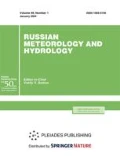Abstract
The results are stated of estimation of short-range forecasting of heavy precipitation (P ≥ 10 mm/12 hours) and strong wind at the height of 10 m (V ≥ 10 m/s) using three nonhydrostatic models from the WRF family: ARW, ARW Glob, and NMM. The forecasts on the basis of all three models were carried out using two grids. The horizontal resolution of external grids varied from 9 to 16.5 km and that of the nested grids, from 3 to 5.5 km. For the ARW and NMM models, the values at side boundaries of external nested grids were taken from the forecasts on the basis of the global GFS NCEP model and for the ARW Glob model, from the global forecasts based on this model. The convection parameterization was turned off at nested grids for all models. The forecasts of heavy precipitation and strong wind at nested grids over the European territory of Russia were estimated from the radar and station measurements in summer 2008. It is obtained that all three models reproduce well enough the mesoscale convective systems and associated areas of heavy precipitation and strong wind but they have common shortcomings: they overestimate the amount and area of heavy precipitation and underestimate the strong wind speed. To a lesser degree, these shortcomings are typical of the ARW model. The possible reasons for systematic errors in the forecasts are discussed.
Similar content being viewed by others
References
Yu. V. Alferov, “An Automated Graphical System for Visualization of Numerical Forecast Results,” Trudy Gidromettsentra Rossii, No. 338 (2003) [Trans. Hydrometcenter of Russia, No. 338 (2003)].
N. F. Vel’tishchev and V. D. Zhupanov, “Experiments on Numerical Modeling of Intense Convection,” Meteorol. Gidrol., No. 9 (2008) [Russ. Meteorol. Hydrol., No. 9, 33 (2008)].
E. A. Aligo and W. A. Gallus, Jr., “On the Impact of WRF Model Vertical Grid Resolution on Midwest Summer Rainfall Forecasts,” Wea. Forecasting, No. 2, 24 (2009).
F. Chen et al., “Modeling of Land-surface Evaporation by Four Schemes and Comparison with FIFE Observations,” J. Geophys. Res., No. D3, 101 (1996).
J. Done et al., “The Next Generation of NWP: Explicit Forecasts of Convection Using the Weather Research and Forecasting (WRF) Model,” Atmos. Sci. Lett., No. 1, 5 (2004).
J. Dudhia, “Numerical Study of Convection Observed during the Winter Monsoon Experiment Using a Mesoscale Two-dimensional Model,” J. Atmos. Sci., No. 20, 46 (1989).
B. S. Ferrier et al., “Implementation of a New Grid-scale Cloud and Precipitation Scheme in the NCEP Eta Model,” in Proceedings of the 15th Conference on Numerical Weather Prediction (Amer. Meteorol. Soc., 2004).
Z. I. Janjic, “The Step-mountain Coordinate: Physical Package,” Mon. Wea. Rev., No. 7, 118 (1990).
Z. I. Janjic, “The Step-mountain Eta Coordinate Model: Further Developments of the Convection, Viscous Sublayer, and Turbulence Closure Schemes,” Mon. Wea. Rev., No. 5, 122 (1994).
Z. I. Janjic, “The Surface Layer in the NCEP Eta Model,” in Proceedings of the 11th Conference on NWP (Amer. Meteorol. Soc., Norfolk, VA, 1996).
I. Jankov et al., “Evaluation and Comparison of Microphysical Algorithms in WRF-ARW Model Simulations of Atmospheric River Events Affecting the California Coast,” CIRA, Spring, 31 (2009).
J. S. Kain, “The Kain-Fritsch Convective Parameterization: An Update,” J. Appl. Meteorol., No. 1, 43 (2004).
J. S. Kain et al., “Some Practical Considerations Regarding Horizontal Resolution in the First Generation of Operational Convection-allowing NWP,” Wea. Forecasting, No. 5, 23 (2008).
C. Keil and G. C. Craig, “A Displacement-based Error Measure in a Regional Ensemble Forecasting System,” Mon. Wea. Rev., No. 9, 35 (2007).
E. J. Mlawer et al., “Radiative Transfer for Inhomogeneous Atmospheres: RRTM, a Validated Correlated-k Model for Longwave,” J. Geophys. Res., No. D14, 102 (1997).
C. E. Newman et al., Planetary and Global WRF. Caltech Experts Guide, http://media.caltech.edu/experts.guide/3175.
M. I. Richardson et al., “Non-conformal Projection, Global, and Planetary Versions of WRF,” in WRF/MM5 Users’ Workshop, June 2005.
N. M. Roberts and H. W. Lean, “Scale-selective Verification of Rainfall Accumulations from High-resolution Forecasts of Convective Events,” Mon. Wea. Rev., No. 1, 136 (2006).
W. Skamarock, “Global WRF Development Version 3, Released 4 April,” in Proceedings of the 9th WRF User’s Workshop, June 23–27, 2008.
W. C. Skamarock and M. L. Weisman, “The Impact of Positive-definite Moisture Transport on NWP Precipitation Forecasts,” Mon. Wea. Rev., No. 1, 137 (2009).
W. C. Skamarock et al., “A Description of the Advanced Research WRF Version 3,” in NCAR Technical Note, June 2008, http://www.mmm.ucar.edu/wrf/users/docs/user.
G. Thompson et al., “Explicit Forecasts of Winter Precipitation Using an Improved Bulk Microphysics Scheme. Part II: Implementation of a New Snow Parameterization,” Mon. Wea. Rev., No. 12, 136 (2008).
User’s Guide for the Advanced Research WRF (ARW) Modeling System Version 3.1. Updated: April 9, 2009, http://www.mmm.ucar.edu/wrf/users/docs/user.
User’s Guide for the NMM Core of the Weather Research and Forecast (WRF) Modeling System Version 3, 8 April 2009, http://www.dtcenter.org/wrf-nmm/users/docs/user-guide/index.php.
M. L. Weisman, “Experiences with 0-36-h Explicit Convective Forecasts with the WRF-ARW Model,” Wea. Forecasting, No. 3, 23 (2008).
H. Wernli et al., “A Novel Quality Measure for the Verification of Quantitative Precipitation Forecasts,” Mon. Wea. Rev., No. 11, 136 (2008).
N. E. Westcott, “Differences in Multi-sensor and Rain-gauge Precipitation Amounts,” Water Management, No. 2, 162 (2009).
Author information
Authors and Affiliations
Additional information
Original Russian Text © N.F. Vel’tishchev, V.D. Zhupanov, Yu.B. Pavlyukov, 2011, published in Meteorologiya i Gidrologiya, 2011, No. 1, pp. 5–18.
About this article
Cite this article
Vel’tishchev, N.F., Zhupanov, V.D. & Pavlyukov, Y.B. Short-range forecast of heavy precipitation and strong wind using the convection-allowing WRF models. Russ. Meteorol. Hydrol. 36, 1–10 (2011). https://doi.org/10.3103/S1068373911010018
Received:
Published:
Issue Date:
DOI: https://doi.org/10.3103/S1068373911010018



